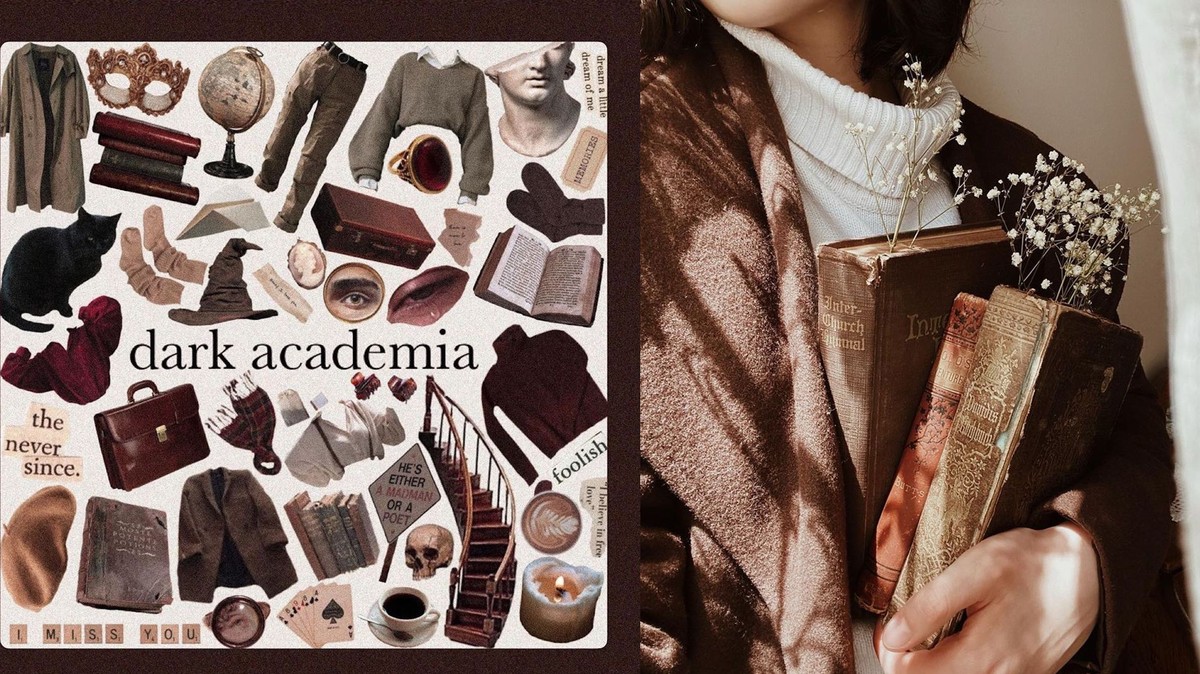Are you a fan of literature that involves academia and the pursuit of knowledge? Then you might want to check out the Dark Academia genre. But what exactly is Dark Academia? In this blog post, we will explore its definition, key elements, characteristics, and even its connection to the LGBTQ community. We will also delve into the colors that best represent this style, as well as its opposite. So sit back, relax, and let’s dive into the world of Dark Academia.
Exploring the Characteristics of the Dark Academia Aesthetic.
Dark Academia is a literary genre that has gained immense popularity in recent years. It is a subculture that is focused on the pursuit of knowledge and classical literature. The genre typically revolves around academic settings and characters, with a focus on the intellectual and aesthetic aspects of learning.
What makes Dark Academia unique is its emphasis on the darker aspects of academic life. It is not just about studying and learning, but also about the struggles and challenges that come with it. The genre often explores themes of isolation, obsession, and even death. It is characterized by a melancholic tone and a sense of foreboding that permeates the narrative.
The key elements of Dark Academia are the setting, the characters, and the themes. The setting is usually an educational institution such as a university or boarding school. The characters are typically students or academics who are passionate about learning and literature. The themes explored in the genre include knowledge, power, morality, and identity.
In a Dark Academia novel, the plot often centers around a mystery or a secret that the characters are trying to unravel. The narrative is usually driven by the characters’ intellectual pursuits and their quest for knowledge. The genre is known for its emphasis on classical literature, with references to works such as Shakespeare, Dante, and Homer.
In conclusion, Dark Academia is a subculture that celebrates the intellectual and aesthetic aspects of learning. It is characterized by its focus on academic settings, characters, and themes, and its exploration of the darker aspects of academic life. It is a genre that has gained a dedicated following for its unique blend of mystery, melancholy, and intellectualism.

🍿 Must Read What was the controversy about Zero Dark Thirty?
Defining the Characteristics of Dark Academia
Dark academia is a unique subculture that has gained popularity on the internet in recent years. It is an aesthetic that focuses on higher education, literature, and the arts, or an idealized version of them. As a subculture, it has its own set of values, beliefs, and practices that distinguish it from mainstream culture. To qualify as dark academia, an individual or piece of art must embody the following key elements:
1. Higher education: Dark academia revolves around the idea of higher education, particularly in the humanities. Literature, philosophy, and history are all subjects that are highly valued in this subculture. The pursuit of knowledge and intellectualism is a central theme in dark academia.
2. The arts: Art is an essential aspect of dark academia, with a particular focus on classical art forms such as painting, sculpture, and architecture. Music and theatre are also highly valued in this subculture.
3. Literature: Dark academia has a deep appreciation for literature, particularly classic works of fiction and poetry. This is reflected in the subculture’s fashion, with many individuals dressing in outfits inspired by characters from classic literature.
4. Gothic and macabre: Dark academia also has a fascination with the gothic and macabre. This is reflected in the subculture’s love for dark, moody aesthetics and literature that explores themes of death and tragedy.
In summary, to qualify as dark academia, an individual or work of art must embody the subculture’s values of higher education, the arts, literature, and a fascination with the gothic and macabre. The subculture is an idealized version of these themes and represents an escape from mainstream culture.
The Vital Ingredients that Define Dark Academia
Dark Academia is a subculture that has become increasingly popular over the years. It is characterized by certain key elements that define its unique aesthetic. The most prominent feature of this style is its focus on classic literature. Books and poetry are revered in the Dark Academia world, and they form the backbone of the entire aesthetic.
Apart from literature, other common themes in Dark Academia include prep and private schools. These schools are often depicted as old and prestigious, with a strong emphasis on tradition and discipline. Classical music is also an integral part of the Dark Academia aesthetic. It is often played in the background of videos and used to create a sense of nostalgia and wistfulness.
Another important theme in Dark Academia is coming of age. This theme is often explored through the lens of existentialism, with characters grappling with questions of identity and purpose. Death and murder are also common themes in Dark Academia. They are often used to create a sense of foreboding and unease, adding a dark twist to an otherwise romantic aesthetic.
Social classes are another important theme in Dark Academia. The subculture often glorifies the upper class, portraying them as cultured and refined. However, it also acknowledges the struggles of those from lower classes, exploring the tension and conflict that arises from these differences.
Romance is the final key element of Dark Academia. It is often depicted as intense and passionate, with characters falling deeply in love and experiencing heartbreak. Overall, Dark Academia is a complex aesthetic that draws from a wide range of themes and elements to create a unique and compelling subculture.

Identifying the Key Traits of Dark Academia Fiction
Dark academia novels have gained immense popularity in recent years, particularly among young adults. The genre is characterized by its academic setting and Gothic elements, which include mystery, thriller, and a touch of the uncanny. The academic setting usually includes elite universities or boarding schools, and the stories often revolve around the lives of young intellectuals. However, what sets dark academia apart from other academic genres is the exploration of darker themes such as love, friendship, and betrayal.
The characters in a dark academia novel are often complex and multi-dimensional, with their darker urges and impulses explored in detail. The relationships between characters are often layered and intricate, with underlying tensions that escalate as the story progresses. These tensions often culminate in betrayal, adding a sense of danger and intrigue to the plot.
Dark academia novels also have a distinct aesthetic, with a focus on the darker side of human nature. The use of Gothic elements such as architecture, art, and literature adds to the overall mood of the story. The setting is often described in detail, with a focus on the darker aspects of the environment.
In summary, dark academia novels are characterized by their academic setting, Gothic elements, and exploration of darker themes. The stories are often complex and layered, with multi-dimensional characters and intricate relationships. The aesthetic is focused on the darker side of human nature, with a focus on Gothic elements and detailed descriptions of the setting.
>> Related – Does Netflix have dark crimes?
Exploring the Distinction between Academic and Dark Academic Aesthetics
When it comes to the difference between academia and dark academia, it’s important to understand that while they share some similarities, they have distinct differences. Academia is more focused on the pursuit of knowledge, the intellectualism of learning, and the academic environment. Light academia, a subgenre of academia, is characterized by its bright and cheery atmosphere. It emphasizes friendship, motivation, and happy endings over pessimism, sadness, and sensitivity.
On the other hand, dark academia is rooted in rather cloudy themes such as literary tragedy, the meaning of life, escapism, and death. It embraces the darker aspects of traditional academia, such as the obsession with knowledge, the pursuit of perfection, and the thirst for intellectual challenge. Dark academia is known for its Gothic architecture, dark clothing, and an overall aesthetic that is reminiscent of the 19th century.
While academia celebrates the pursuit of knowledge, dark academia is more focused on the darker aspects of the academic world. It is a subculture that has gained immense popularity over the years and has become a way of life for many. The emphasis on the darker themes in dark academia makes it a unique subculture that is distinct from academia and light academia.
In conclusion, academia and dark academia have distinct differences when it comes to their themes, aesthetics, and overall atmosphere. While academia is more focused on the pursuit of knowledge and intellectualism, dark academia is rooted in Gothic themes, tragedy, and intellectual challenge. The contrast between these two subcultures highlights the diverse range of interests and passions that people have.
Exploring the Relationship between Dark Academia and the LGBTQ Community.
Dark academia is not just about books, libraries, and education. It is also about the emotions and experiences that come with it, and one of those experiences is queerness. In fact, dark academia is often associated with queerness, and for good reason. The genre’s connection to the English school story brings with it a sense of gay yearning that is often conveyed through covert classical references and Shakespearean sonnets. The subtext of same-sex attraction is a common theme in many dark academia novels, making it a genre that is not only academic but also deeply emotional.
The queer undertones of the genre are not surprising given the historical context of English schools. For centuries, many English schools have been all-boys institutions, and the relationships formed between students were often intense and emotional. These relationships were often romantic in nature, and many famous English writers, such as Oscar Wilde and E.M. Forster, were known to be queer. It is this history and the associated emotions that make dark academia such a popular genre among LGBTQ+ individuals.
The classic literary references and the somber aesthetic of dark academia also provide a safe space for queer individuals to explore their identity. The genre’s focus on education and the pursuit of knowledge is empowering for many LGBTQ+ individuals, who may have faced discrimination and exclusion in traditional educational settings. The genre’s popularity among queer individuals also means that it has become a community in its own right, with many online forums and social media pages dedicated to exploring and celebrating the genre’s queer themes.
In conclusion, dark academia is a genre that is often associated with queerness. The genre’s connection to the English school story, the emotional intensity of relationships between students, and the classic literary references all contribute to the queer undertones of dark academia. The genre’s popularity among LGBTQ+ individuals has also created a community that celebrates and explores its queer themes.

Exploring the Dark Aesthetic of Colors in the Academic World
Dark academia is a unique subculture that has taken the internet by storm. It is characterized by its love for classic literature, Gothic architecture, and a certain color palette. If you are interested in this subculture, you may be wondering what colors are considered “darkest academia.”
The answer is simple: black and red. These two colors dominate the darkest academia’s color palette. Black represents the darkness and mystery that is often associated with classic literature and Gothic architecture. Red, on the other hand, represents passion, power, and the macabre. Together, they create a bold and striking contrast that is both elegant and sinister.
It is worth noting that while academia visuals typically feature architecture, goth academia features Gothic architecture almost exclusively. The intricate and ornate designs of these buildings perfectly capture the essence of the subculture. The use of black and red along with the Gothic architecture creates a visually pleasing and cohesive aesthetic that is instantly recognizable.
In conclusion, if you want to embrace the darkest academia style, you should incorporate black and red into your wardrobe and home decor. You should also seek out Gothic architecture and design elements to create a cohesive and visually stunning look.
Exploring the Antithesis of Dark Academia Fashion Trends.
Dark Academia is a popular aesthetic that has gained significant attention on social media platforms. It is known for its dark and brooding appearance, with a focus on classic literature, mythology, and history. However, not everyone is drawn to the darker side of academia. For those who prefer a lighter and brighter aesthetic, there is Light Academia.
Light Academia is the polar opposite of Dark Academia. While Dark Academia emphasizes darker colors such as black, navy, and forest green, Light Academia is characterized by soft pastels, ivory, and cream tones. It is more focused on the natural world, with a preference for floral patterns, lace, and light fabrics.
In terms of literature and history, Light Academia is more likely to focus on less intense subjects, such as art history, poetry, and romantic literature. It is also more optimistic in tone, often incorporating themes of hope, nostalgia, and whimsy.
While Dark Academia has a somewhat gothic and brooding vibe, Light Academia is more whimsical and romantic. It evokes a sense of innocence and naivety, which is reflected in its fashion and aesthetic choices.
In conclusion, Light Academia is the antithesis of Dark Academia. While Dark Academia is focused on the darker side of academia, Light Academia is more focused on the lighter and more whimsical side. It is a more playful and romantic aesthetic, with a focus on pastel colors, floral prints, and softer fabrics.
More to discover
Dark Academia is a unique and intriguing genre that focuses on academia and learning. It is characterized by its emphasis on classical literature, educational institutions, and the pursuit of knowledge. The key elements of Dark Academia include a love for aesthetics, intellectualism, and a passion for learning. Dark Academia novels are known for their complex characters, intricate plotlines, and philosophical themes. While it may not be explicitly LGBTQ, the genre does include queer representation. The color scheme of Dark Academia is typically dark and muted, with shades of black, gray, and brown. The opposite of Dark Academia style is known as Light Academia, which incorporates brighter colors and a more whimsical aesthetic. Overall, Dark Academia is a captivating and thought-provoking genre that continues to gain popularity among readers and writers alike.
